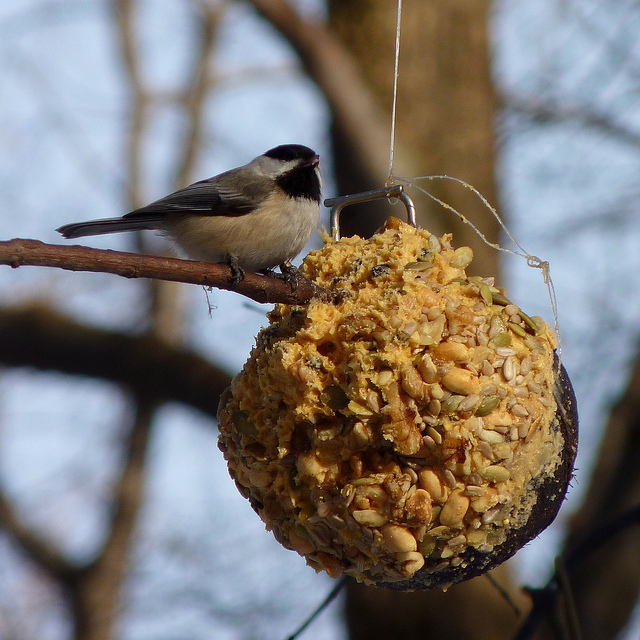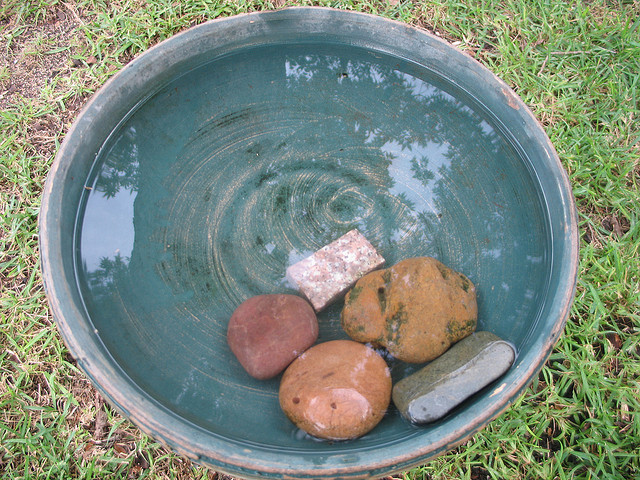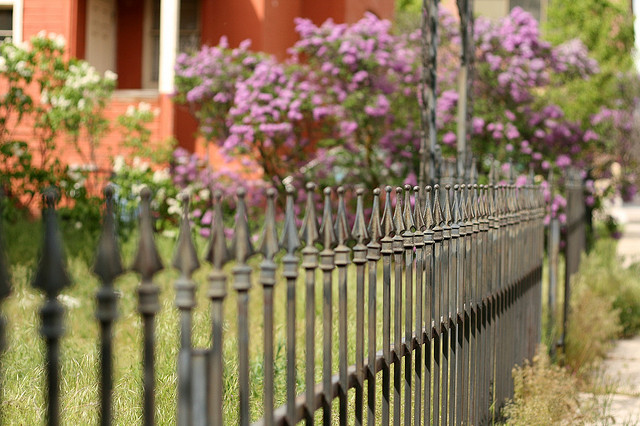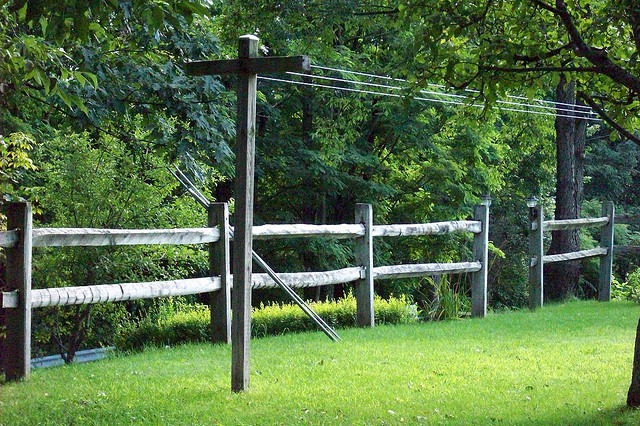024 - How to Create a Wildlife-Friendly Yard
Habitat can be hard to come by for wildlife in urban areas. A wildlife-friendly yard provides food, water, cover, and a safe place to rear young.
Food
Native forbs, shrubs and trees provide food for wildlife and birds with their foliage, nectar, pollen, fruit (berries, seeds, nuts, etc.), and bark. You can select the landscape plants that will attract the birds and other wildlife you want to encourage from the list at the end of this fact sheet. When food is scarce in winter it can be helpful to place feeders for birds in your yard to supplement naturally occurring food. You can also attract butterflies to your yard by supplementing their food sources. Mix 9 parts water to 1 part sugar, pour the mixture over cut up old, mushy fruit–oranges, peaches or pears–on a plate and suspend the plate high in a tree to prevent unwanted wildlife from disturbing the feeder. Hummingbirds are attracted to red, tubular flowers and feeders can provide food when flowering species are scarce. Information on hummingbird feeders, nectar recipes and the importance of maintaining clean feeders can be found online.

Water

Installing a water source in your yard is a simple way to benefit wildlife and birds. Clean water is essential but often not available in the arid West. Provide water in a bird bath or other water feature. Anything that will hold water will work, like a hubcap or a similar shallow basin. Remember to clean the water source weekly and change the water two to three times a week.
Cover
Birds and other wildlife require cover to be safe from predators, weather, and people. Increasing plant structure between the ground and tree canopies with shrubs and non-woody plants is called vertical layering. By creating a multi-layered vegetation structure in your yard, you can provide cover for a variety or birds, other wildlife, and insects. Choose native plant species when possible (see list at the end of this fact sheet). When pruning vegetation and mowing your lawn, let some areas or branches go uncut. They will provide seeds and cover for small species such as insects, frogs, and other amphibians.
Safe Place to Rear Young
It takes a lot of energy for wildlife to successfully rear young in the wild. This effort increases when safe nesting spots are scarce. You can ease some of this pressure for nesting species by placing birdhouses, bat boxes or nest boxes in your yard.
Woodpeckers, nuthatches, creepers and wrens require cavities for nesting. Leaving dead snags on the landscape will benefit these species, although large snags can be dangerous. To determine the best birdhouse design to incorporate into your yard, see recommendations from the National Wildlife Federation. Type “birdhouse” in the search feature.
You can contribute to a long-standing database on birds currently being collected by the Cornell Lab of Ornithology. Visit nestwatch.org and record the species you observe every day.
Wildlife-friendly Fences
Ranch Fences
Fences are an important part of any yard or landscape. They are necessary for determining property boundaries, controlling trespass, and in the case of farmers and ranchers, enclosing pastures.
Residential Fences
The most important factor to consider when constructing or retrofitting the fence in your yard is ensuring that it is visible to birds and other wildlife. When fences are difficult to see, wildlife can collide or become caught in them. If you have a wire fence in your yard, consider placing a wood rail or PVC pipe on top to increase visibility and safety for jumping deer. Many decorative fence designs can be hazards to deer or other ungulates. Fences with sharp tips should be avoided if possible. Wildlife- and bird-friendly options include chain-link, post and rail, post and pole, or board fences. You can even create a vegetative barrier with shrubs and/or small trees. Good yard barrier shrub species include thimbleberry, raspberry, blackberry, snowberry, wild rose, Oregon-grape, barberry, and firethorn.


Are bats good for your yard? Bats are the only true flying mammal in the world. Eighteen bat species exist in Utah. Of these only three exist in urban landscapes: the little brown bat, the big brown bat, and the Brazilian free-tailed bat. Their diet consists primarily of beetles, mosquitoes, moths, wasps, and midges. A single little brown bat can consume up to 1,000 mosquito-sized insects in just one hour. Maintaining healthy bat populations benefits ecosystems because bats pollinate flowers and crops, eat some of the most damaging agricultural insects, and disperse a wide variety of seeds. Bat populations are declining almost everywhere due to pesticides, insecticides, habitat degradation, and cave disturbances. You can easily build a bat house (see Bat Conservation International) and give these important mammals a place to live. Incorporating a bat house into your yard can help reduce pests and ensure that these important mammals have a safe place to rear their young.
Too many deer in your yard already? Every year, especially in the winter, wildlife agencies receive complaints from people that deer are eating the vegetation in their yard. There are many aspects to the complex problem, but one thing that most parties agree on is the need to improve native deer habitat. Focusing on boosting the quality of native deer habitat will likely deter deer from seeking forage in the yards and gardens of urban and suburban residents living along the Wasatch Front and elsewhere. See our factsheet here for more information about deer in landscapes.
Natives are best: Why go native? Native plants are hardy to local growing and soil conditions. Native species are more likely to be healthy and to require fewer chemical treatments and less maintenance and water than non-native species. Choosing native plants will benefit birds, other wildlife and insects, and in the long run will ultimately save time and resources. It’s important to know what is native to your particular site. Quaking aspen, for example, is native to Utah’s mountains, but not to low elevations where most people live. It does not do well in hot, dry, low-elevation sites.
Plant List for Wildlife-friendly Landscaping
The following table does not include all appropriate plants and may include plants that are not suitable for your particular situation. Learn about what the plant needs and where it can be grown well by looking through the references at the end of this fact sheet.
Plants and the Species They Benefit
| Plant Type | Common Name | Scientific Name | Hummingbirds | Bees | Butterflies | Birds | Small Mammals |
|---|---|---|---|---|---|---|---|
| Herbaceous Perennials | abelia | Abelia spp. | ✔ | ||||
| Herbaceous Perennials | ageratum, purple | Ageratum spp. | ✔ | ||||
| Herbaceous Perennials | alyssum, sweet | Lobularia maritima | ✔ | ||||
| Herbaceous Perennials | aster, Frikart’s | Aster x frikartii | ✔ | ||||
| Herbaceous Perennials | bee balm, scarlet | Monarda didyma | ✔ | ✔ | ✔ | ||
| Herbaceous Perennials | beeplant, Rocky Mountain | Cleome serrulata | ✔ | ||||
| Herbaceous Perennials | black-eyed Susan | Rudbeckia hirta | ✔ | ||||
| Herbaceous Perennials | bluebeard | Caryopteris divaricata | ✔ | ||||
| Herbaceous Perennials | buckwheat, sulphurflower | Eriogonum umbellatum | ✔ | ✔ | ✔ | ||
| Herbaceous Perennials | butterfly weed | Asclepias tuberosa | ✔ | ||||
| Herbaceous Perennials | cardinal flower | Lobelia cardinalis | ✔ | ||||
| Herbaceous Perennials | catnip | Nepeta cataria | ✔ | ||||
| Herbaceous Perennials | columbine | Aquilegia spp. | ✔ | ✔ | |||
| Herbaceous Perennials | coneflower, purple | Echinacea purpurea | ✔ | ✔ | ✔ | ||
| Herbaceous Perennials | coralbells | Heuchera sanguinea | ✔ | ||||
| Herbaceous Perennials | coreopsis, giant | Coreopsis gigantea | ✔ | ✔ | |||
| Herbaceous Perennials | coreopsis, threadleaf | Coreopsis verticillata | ✔ | ||||
| Herbaceous Perennials | daisy, Shasta | Leucanthemum x superbum | ✔ | ||||
| Herbaceous Perennials | dandelion | Taraxacum officinale | ✔ | ✔ | |||
| Herbaceous Perennials | desert lavender | Hyptis emoryi | ✔ | ✔ | ✔ | ||
| Herbaceous Perennials | dill | Anethum graveolens | ✔ | ||||
| Herbaceous Perennials | evening primrose, white-tufted | Oenothera caespitosa | ✔ | ||||
| Herbaceous Perennials | four o’clock | Mirabilis multiflora | ✔ | ||||
| Herbaceous Perennials | foxglove | Digitalis spp. | ✔ | ||||
| Herbaceous Perennials | gilia, scarlet | Ipomposis aggregata | ✔ | ||||
| Herbaceous Perennials | goldenrod | Solidago spp. | ✔ | ✔ | ✔ | ||
| Herbaceous Perennials | hyssop, anise or blue giant | Agastache foeniculum | ✔ | ✔ | ✔ | ||
| Herbaceous Perennials | Indian paintbrush, narrowleaf | Castilleja linariifolia | ✔ | ||||
| Herbaceous Perennials | larkspur | Delphinium spp. | ✔ | ✔ | |||
| Herbaceous Perennials | lemon balm | Melissa officinalis | ✔ | ||||
| Herbaceous Perennials | lily, tiger | Lilium lancifolium | ✔ | ||||
| Herbaceous Perennials | lupine | Lupinus perennis | ✔ | ||||
| Herbaceous Perennials | marigold, French | Tagetes patula | ✔ | ||||
| Herbaceous Perennials | milkweed | Asclepias spp. | ✔ | ||||
| Herbaceous Perennials | mint | Mentha spp. | ✔ | ✔ | |||
| Herbaceous Perennials | parsley | Petroselinum crispum | ✔ | ||||
| Herbaceous Perennials | penstemon, firecracker | Penstemon eatonii | ✔ | ✔ | ✔ | ✔ | ✔ |
| Herbaceous Perennials | phlox, garden | Phlox paniculata | ✔ | ✔ | |||
| Herbaceous Perennials | prairie clover, western | Dalea ornata | ✔ | ✔ | |||
| Herbaceous Perennials | rosemary | Rosmarinus officinalis | ✔ | ✔ | |||
| Herbaceous Perennials | sage | Salvia officinalis | ✔ | ✔ | |||
| Herbaceous Perennials | speedwell | Veronica spp. | ✔ | ||||
| Herbaceous Perennials | sunflower | Helianthus annuus | ✔ | ||||
| Herbaceous Perennials | sweet William | Dianthus barbatus | ✔ | ✔ | |||
| Herbaceous Perennials | thistle, New Mexico | Cirsium neomexicanum | ✔ | ✔ | |||
| Herbaceous Perennials | thyme | Thymus praecox | ✔ | ||||
| Herbaceous Perennials | trumpet, hummingbird | Epilobium canum | ✔ | ✔ | |||
| Herbaceous Perennials | valerian, red | Centranthus ruber | ✔ | ✔ | |||
| Herbaceous Perennials | yarrow, common | Achillea millefolium | ✔ | ✔ | ✔ | ||
| Herbaceous Perennials | yucca, red | Hesperaloe parviflora | ✔ | ✔ | |||
| Herbaceous Perennials | zinnia, narrowleaf | Zinnia angustifolia | ✔ | ||||
| Shrubs | acacia, catclaw | Acacia greggii | ✔ | ✔ | ✔ | ✔ | |
| Shrubs | Apache plume | Fallugia paradoxa | ✔ | ✔ | |||
| Shrubs | bitterbrush | Purshia tridentata | ✔ | ✔ | ✔ | ||
| Shrubs | buffaloberry, roundleaf | Sheperdia rotundifolia | ✔ | ✔ | |||
| Shrubs | buffaloberry, silver | Sheperdia argentea | ✔ | ||||
| Shrubs | butterflybush, woolly | Buddleia marrubiifolia | ✔ | ✔ | ✔ | ||
| Shrubs | chokecherry | Prunus virginiana | ✔ | ✔ | ✔ | ||
| Shrubs | cinquefoil, shrubby | Potentilla fruticosa | ✔ | ✔ | |||
| Shrubs | cliffrose | Purshia mexicana | ✔ | ||||
| Shrubs | creosotebush | Larrea tridentata | ✔ | ✔ | ✔ | ||
| Shrubs | currant, golden | Ribes aureum | ✔ | ✔ | ✔ | ✔ | ✔ |
| Shrubs | dalea, Gregg | Dalea greggii | ✔ | ✔ | |||
| Shrubs | dogwood, redosier | Cornus sericea | ✔ | ✔ | |||
| Shrubs | elderberry, blue | Sambucus caerulea | ✔ | ✔ | ✔ | ||
| Shrubs | fernbush | Chamaebatiaria millefolium | ✔ | ✔ | |||
| Shrubs | greasewood | Sarcobatus vermiculatus | ✔ | ||||
| Shrubs | honeysuckle, Utah | Lonicera utahensis | ✔ | ✔ | |||
| Shrubs | indigo bush | Amorpha fruticosa | ✔ | ✔ | |||
| Shrubs | lilac | Syringa vulgaris | ✔ | ||||
| Shrubs | mesquite, western honey | Prosopis glandulosa | ✔ | ||||
| Shrubs | mockorange | Philadelphus lewisii | ✔ | ✔ | ✔ | ||
| Shrubs | Mormon tea | Ephedra viridis | ✔ | ✔ | |||
| Shrubs | mountain-mahogany, alderleaf | Cercocarpus montanus | ✔ | ✔ | ✔ | ||
| Shrubs | oak, shrub live | Quercus turbinella | ✔ | ✔ | |||
| Shrubs | rabbitbrush, yellow | Chrysothamnus viscidiflorus | ✔ | ✔ | ✔ | ||
| Shrubs | rose, Woods’ | Rosa woodsii | ✔ | ✔ | ✔ | ||
| Shrubs | sage, fringed | Artemisia frigida | ✔ | ✔ | ✔ | ||
| Shrubs | sage, purple | Poliomintha incana | ✔ | ✔ | |||
| Shrubs | sage, sand | Artemisia filifolia | ✔ | ✔ | ✔ | ||
| Shrubs | sagebrush, big | Artemisia tridentata | ✔ | ✔ | |||
| Shrubs | sagebrush, silver | Artemisia cana | ✔ | ✔ | |||
| Shrubs | saltbush, four-wing | Atriplex canescens | ✔ | ✔ | |||
| Shrubs | sand cherry, western | Prunus besseyi | ✔ | ✔ | |||
| Shrubs | serviceberry, Utah | Amelanchier utahensis | ✔ | ✔ | |||
| Shrubs | skunkbush | Rhus trilobata | ✔ | ✔ | |||
| Shrubs | snowberry, common | Symphoricarpos albus | ✔ | ✔ | |||
| Shrubs | stretchberry | Forestiera pubescens var. pubescens | ✔ | ✔ | ✔ | ✔ | |
| Shrubs | sumac | Rhus spp. | ✔ | ✔ | ✔ | ||
| Shrubs | viburnum | Viburnum spp. | ✔ | ✔ | |||
| Shrubs | willow | Salix spp. | ✔ | ✔ | |||
| Shrubs | willow, sandbar | Salix interior | ✔ | ✔ | |||
| Shrubs | winterfat | Krascheninnikovia lanata | ✔ | ✔ | |||
| Shrubs | yucca, soap tree | Yucca elata | ✔ | ✔ | |||
| Trees | alder | Alnus spp. | ✔ | ||||
| Trees | alder, gray | Alnus incana | ✔ | ✔ | |||
| Trees | alder, thinleaf | Alnus tenuifolia | ✔ | ✔ | ✔ | ||
| Trees | ash, singleleaf | Fraxinus anomala | ✔ | ✔ | |||
| Trees | birch, water | Betula occidentalis | ✔ | ✔ | ✔ | ||
| Trees | catalpa, southern | Catalpa bignoniodes | ✔ | ||||
| Trees | cottonwood, Fremont | Populus fremontii | ✔ | ✔ | |||
| Trees | cottonwood, narrowleaf | Populus angustifolia | ✔ | ✔ | |||
| Trees | desert-willow | Chilopsis linearis | ✔ | ✔ | ✔ | ✔ | |
| Trees | Douglas-fir | Pseudotsuga menziesii | ✔ | ✔ | |||
| Trees | fir, subalpine | Abies lasiocarpa | ✔ | ✔ | |||
| Trees | hawthorn, Douglas | Crataegus douglasii | ✔ | ✔ | ✔ | ||
| Trees | horsechestnut | Aesculus hippocastanum | ✔ | ✔ | |||
| Trees | juniper, Utah | Juniperus osteosperma | ✔ | ✔ | |||
| Trees | locust, black | Robinia pseudoacacia | ✔ | ✔ | ✔ | ||
| Trees | locust, New Mexico | Robinia neomexicana | ✔ | ✔ | ✔ | ✔ | ✔ |
| Trees | maple, bigtooth | Acer grandidentatum | ✔ | ✔ | |||
| Trees | mountain-mahogany, curlleaf | Cercocarpus ledifolius | ✔ | ✔ | |||
| Trees | mountainash, Greene | Sorbus scopulina | ✔ | ||||
| Trees | mesquite, velvet | Prosopis velutina | ✔ | ✔ | ✔ | ||
| Trees | oak, gambel | Quercus gambelii | ✔ | ✔ | ✔ | ||
| Trees | pine, pinyon | Pinus edulis | ✔ | ✔ | |||
| Trees | pinyon, singleleaf | Pinus monophylla | ✔ | ✔ | ✔ | ✔ | |
| Trees | spruce | Picea spp. | ✔ | ✔ | |||
| Vines | grape, Arizona | Vitis arizonica | ✔ | ✔ | |||
| Vines | honeysuckle, twinberry | Lonicera involucrata | ✔ | ✔ | ✔ | ✔ | |
| Vines | trumpet creeper | Campsis radicans | ✔ | ✔ |
Photo Credits by Appearance in Article
- Flickr user “Dendroica cerulea”
- Flickr user “Nieve44/Luz"
- Flickr user “DieselDemon”
- Flickr user “Alexcion”
Photos are licensed under the Creative Commons 2.0 Attribution License
Resources
Many resources are available for people interested in designing and maintaining landscapes for wildlife. These include:
- Landscaping for a variety of species in the Rocky Mountain Region
- General info on landscaping for wildlife:
- Landscape tips specific for Utah
- General info on landscaping for birds and bats:
Published December 2013.

